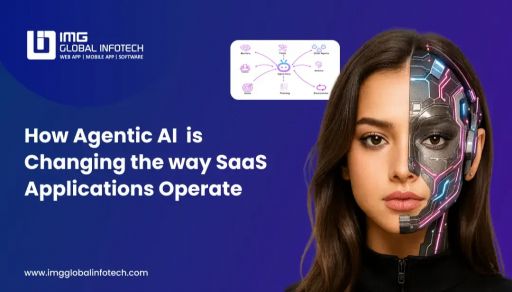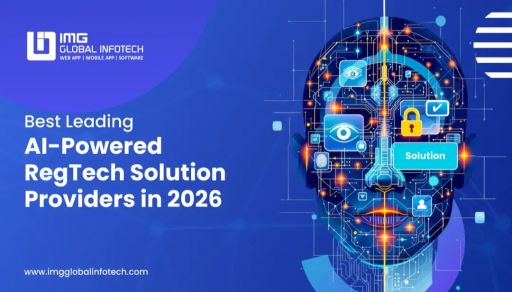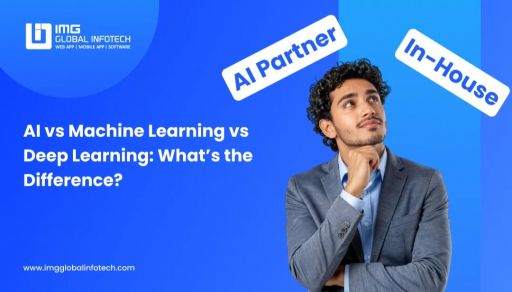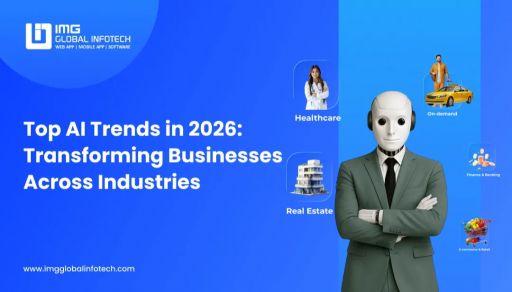How AI Is Used In Restaurants: Use Cases & Real Examples
Dipti Singhal
Jun 21, 2025

The restaurant industry is undergoing a technological transformation, and at the center of it is Artificial Intelligence (AI). From fast food chains to fine dining establishments, restaurants are embracing AI to streamline operations, improve customer service, and stay competitive in a rapidly evolving market.
Today, AI in restaurants is not just a trend, it's a powerful tool driving innovation across the food service landscape. Whether it's predicting customer preferences, automating food preparation, or analyzing customer feedback, the use of artificial intelligence in restaurants is reshaping how businesses operate and interact with their customers.
Major brands are already leading the way. For example, AI in McDonald’s restaurants is optimizing drive-thru efficiency, while Yum Brands is using AI to enhance kitchen operations across its outlets like KFC and Taco Bell. Meanwhile, voice-based solutions such as SoundHound for restaurants are making ordering easier and faster for customers, especially in high-volume settings.
From AI robots in restaurants to smart menus and dynamic pricing, this new wave of restaurant artificial intelligence is solving real-world problems. In this blog, we’ll explore the most impactful AI use cases in restaurants, showcase real-life examples, and uncover how any restaurant big or small can benefit from adopting AI.
Top Use Cases of AI in the Restaurant Industry
The implementation of AI in the restaurant industry is helping businesses become smarter, faster, and more efficient. From kitchen operations to customer engagement, AI is transforming every touchpoint of the dining experience.
Let’s explore the top use cases of artificial intelligence in restaurants:
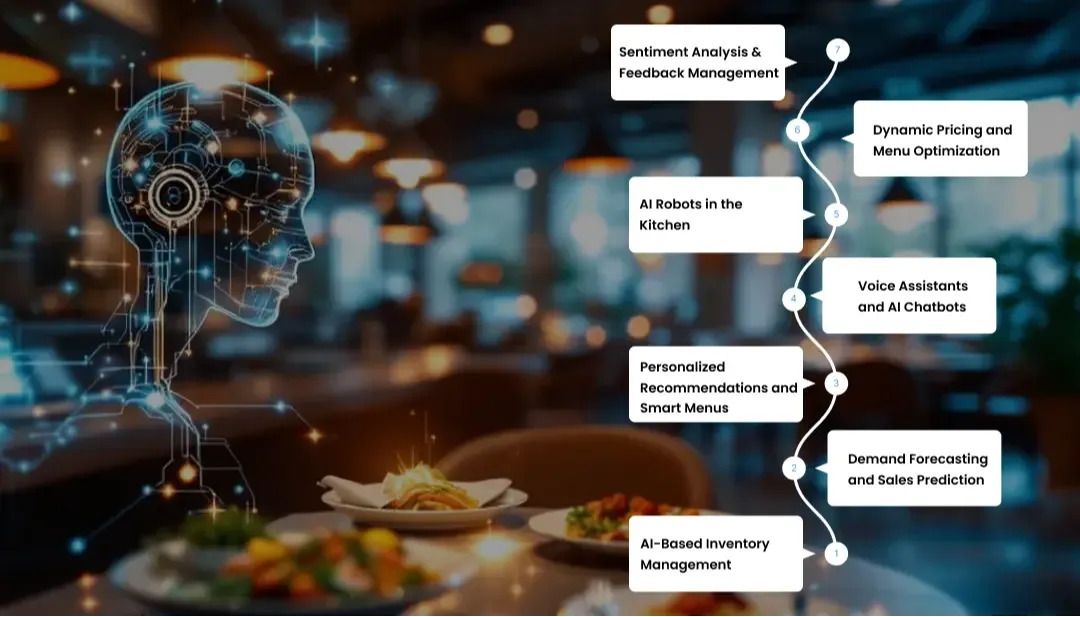
1. AI-Based Inventory Management
Managing inventory is one of the most complex challenges in restaurant operations. AI systems can analyze historical sales data, real-time usage, weather patterns, and local events to accurately forecast demand. This ensures that restaurants stock just the right amount reducing waste and preventing shortages.
With AI for restaurants, real-time alerts can notify managers when stock is low or nearing expiration, helping maintain optimal kitchen performance.
2. Demand Forecasting and Sales Prediction
AI tools can identify trends in customer behavior and predict what items are likely to be ordered and when. This helps in preparing food more efficiently and assigning the right number of staff during peak hours.
For instance, AI can predict increased coffee sales on rainy mornings or spike in family meals during holidays automating resource planning.
3. Personalized Recommendations and Smart Menus
Personalization drives customer loyalty. With AI, restaurants can track past orders, dietary preferences, and time of visit to offer custom suggestions. Smart menus adapt in real time to recommend the best meals, deals, or combos.
Restaurants in California and other tech-forward regions are already leveraging AI restaurant technologies to enhance user experience.
4. Voice Assistants and AI Chatbots
One of the most popular AI use cases in restaurants is automating customer interactions through voice and chat assistants. Tools like SoundHound for restaurants allow customers to place orders, ask about allergens, and make reservations all via voice.
These AI systems reduce staff workload and enhance speed and convenience, especially in fast food restaurants.
5. AI Robots in the Kitchen
AI-powered robots are changing how food is prepared, cooked, and served. From flipping burgers to frying fries, these robots work with speed and precision while reducing human error.
For example, the famous AI robots in restaurants like CaliExpress use Flippy the burger-flipping robot to prepare meals in fully automated kitchens.
6. Dynamic Pricing and Menu Optimization
AI helps restaurants analyze which items sell best, at what times, and in what seasons. Based on these insights, it can recommend pricing adjustments or promotional campaigns to maximize revenue.
This type of restaurant intelligence ensures that pricing and menu strategies are always aligned with customer behavior and market demand.
7. Sentiment Analysis & Feedback Management
AI tools can scan and analyze online reviews, social media posts, and customer surveys to detect sentiments, highlight common complaints, and suggest improvements.
This proactive feedback loop ensures better service quality and strengthens brand reputation.
Real-World Examples of AI in Restaurants
Many global restaurant chains are already using artificial intelligence in restaurants to improve efficiency, boost sales, and offer better customer experiences. These examples prove that AI in restaurant business is not just experimental, it's delivering measurable results.
Let’s look at how some of the world’s most recognized food brands are leveraging AI in restaurants:
-
McDonald’s – AI for Drive-Thru and Personalization
McDonald’s has heavily invested in AI technologies. In 2019, it acquired Dynamic Yield, a personalization platform that uses AI to modify digital drive-thru menus in real-time based on weather, traffic, trending items, and more.
The company also tested voice-based ordering using AI at drive-thrus to reduce wait times and streamline orders, showing a strong example of AI in McDonald’s restaurants.
-
Yum Brands – AI to Improve Operational Efficiency
Yum Brands is the parent company of KFC, Pizza Hut, and Taco Bellis implementing AI across multiple business areas. They use AI to:
-
Predict cooking times
-
Optimize ingredient usage
-
Manage kitchen workflow
-
Offer smarter delivery routing
In KFC outlets in China, AI is even used for facial recognition ordering, speeding up transactions and improving customer personalization.
-
Starbucks – Deep Brew for Personalization & Planning
Starbucks introduced Deep Brew, an AI engine that powers:
-
Personalized recommendations via the Starbucks app
-
Predictive inventory stocking
-
Store-level labor optimization
-
Voice ordering via smart devices
With AI, Starbucks can offer tailored promotions and suggestions, boosting customer engagement while also improving store operations.
-
Domino’s – AI for Ordering, Delivery & Kitchen Insights
Domino’s Pizza uses AI in several innovative ways:
-
Dom – an AI chatbot for voice-based ordering
-
GPS tracking for delivery vehicles
-
AI-powered quality control that uses computer vision to ensure pizzas are made correctly
-
Predictive tools to optimize delivery routes and order prep times
The AI integration has helped Domino’s reduce delivery errors, speed up service, and improve consistency.
-
CaliExpress by Flippy – Fully Robotic AI Restaurant in California
Located in California, CaliExpress is a groundbreaking AI restaurant using Flippy, an AI-powered robotic chef, to cook burgers and fries with high accuracy and speed. The restaurant uses sensors, cameras, and real-time data to automate kitchen operations almost entirely.
This is a top example of an AI restaurant in California showcasing how robotic automation can run a kitchen with minimal human intervention.
-
KFC + Alibaba – Smart Restaurant in China
KFC partnered with Alibaba to create a fully smart restaurant in China, equipped with:
-
Facial recognition ordering and payment
-
AI-powered nutrition analysis
-
Smart menu recommendations
Customers can walk in, smile at a screen to access their profile, place an order, and pay—all without interacting with staff.
Benefits of AI Adoption in Restaurants
The adoption of AI in restaurants is not just a technological upgrade, it's a strategic move that delivers tangible value. Whether it's increasing efficiency, enhancing customer service, or cutting costs, the benefits of artificial intelligence in restaurants are extensive and game-changing.
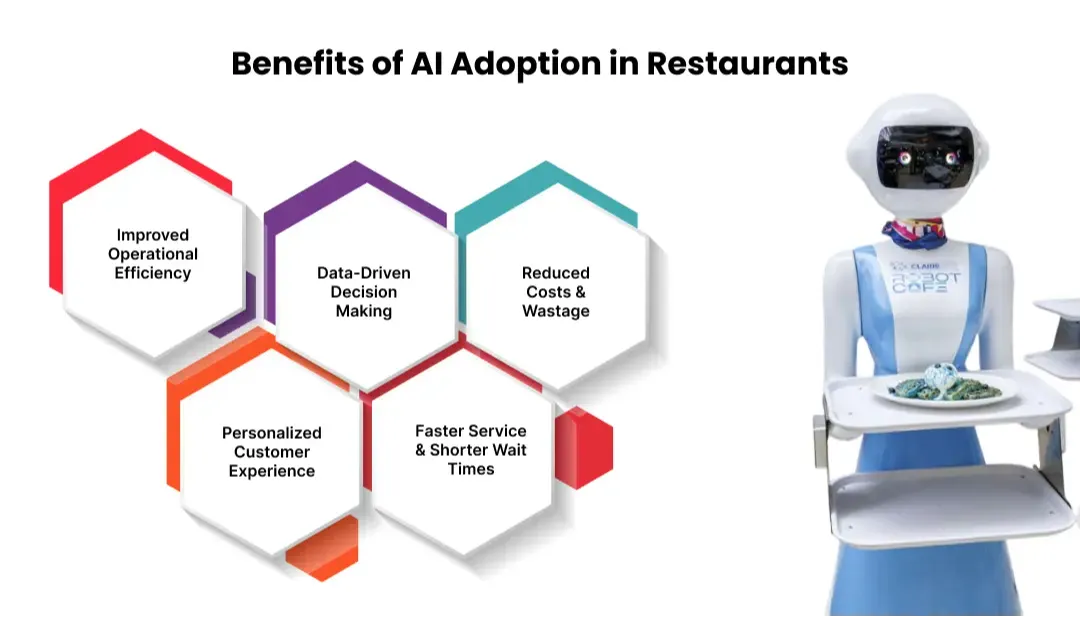
Improved Operational Efficiency
AI helps automate repetitive and time-consuming tasks such as inventory tracking, order processing, staff scheduling, and cooking processes. This streamlines restaurant operations and reduces human error.
For example, AI in fast food restaurants can ensure that fryers automatically start or stop based on real-time demand data saving energy and ensuring consistency.
Data-Driven Decision Making
Restaurants generate a massive amount of data customer orders, inventory levels, staffing performance, reviews, and more. AI tools process and analyze this data to provide actionable insights.
This restaurant intelligence enables smarter decisions like which dishes to promote, when to run offers, and how to reduce food waste or improve ROI.
Reduced Costs & Wastage
AI-powered systems help monitor usage and expiration of ingredients, track waste patterns, and adjust purchase orders automatically. Predictive analytics help prevent over-ordering or under-ordering, reducing spoilage.
AI robots in restaurants can also reduce labor costs by automating kitchen tasks that would otherwise require multiple staff members.
Personalized Customer Experience
AI analyzes customer behavior and preferences to offer tailored recommendations, promotions, and loyalty rewards. This leads to higher satisfaction and repeat business.
For instance, AI in McDonald’s restaurants uses dynamic menu displays that change based on time, weather, and order history to improve relevance and upsell potential.
Faster Service & Shorter Wait Times
AI voice assistants like SoundHound for restaurants enable hands-free, quick ordering ideal for busy environments or drive-thrus. Chatbots and digital kiosks reduce pressure on staff and enhance customer satisfaction.
This is particularly impactful in AI restaurants in California and other tech-forward regions.
Challenges of Implementing AI in Restaurants
While the use of artificial intelligence in restaurants offers impressive benefits, it’s not without challenges. Many restaurant owners, especially small and medium businesses face roadblocks when adopting AI-powered technologies.
High Initial Investment
Setting up AI solutions like robots, smart kitchen appliances, or advanced analytics platforms often involves substantial upfront costs. From purchasing hardware to integrating systems and training staff, the initial setup can be expensive.
This is especially true for features like AI robots in restaurants or installing advanced SoundHound for restaurants voice assistants.
While enterprise-level brands like McDonald’s and Yum Brands can absorb these costs, smaller restaurants may find it financially challenging.
Staff Training and Resistance to Change
Introducing AI in restaurants requires staff to adapt to new technologies. This can cause resistance, especially among employees who are less tech-savvy or fear job loss due to automation.
Training employees to work alongside AI tools—like robotic assistants or AI dashboards—is crucial for smooth adoption. Failure to do so may result in poor implementation and wasted investment.
Data Privacy and Security Concerns
AI systems collect vast amounts of customer data preferences, order history, payment information, and even biometric data in some cases (e.g., facial recognition used in KFC China). This raises concerns about data storage, compliance, and privacy.
Restaurants must ensure that their AI systems in the restaurant industry comply with regulations like GDPR or local data protection laws.
Technology Integration and Compatibility Issues
Legacy POS systems, outdated kitchen equipment, or fragmented software stacks can create integration issues. AI tools often require modern infrastructure to function properly.
Without proper integration, AI may not perform at its full potential—limiting the ROI and creating operational inefficiencies.
Uncertainty Around ROI and Performance
While large brands have seen success with AI, many smaller operators are hesitant due to uncertain returns on investment. Not every AI solution guarantees immediate benefits, especially if not aligned with business goals.
It takes time, data, and consistent optimization to see the true impact of AI in restaurants and that uncertainty can slow adoption.
Future Trends: What’s Next for AI in Restaurants?
As technology evolves, the role of AI in restaurants is expected to grow even more dynamic, intelligent, and personalized. Restaurants that embrace these innovations will stay ahead of customer expectations and competitive pressures.
Let’s take a look at the key future trends shaping AI in the restaurant industry:
AI + IoT Integration for Smart Kitchens
The combination of AI and IoT (Internet of Things) is already transforming kitchens into intelligent ecosystems. Sensors and smart devices can now communicate with AI systems to automate:
-
Temperature regulation
-
Real-time equipment diagnostics
-
Spoilage detection
-
Inventory reordering
For example, a refrigerator could detect low ingredient levels and trigger an AI-generated order, ensuring stock never runs out.
Hyper-Personalization Through Predictive AI
Future AI for restaurants will offer even deeper personalization by using predictive algorithms to tailor experiences. Based on dietary habits, allergies, past orders, weather, and even mood (via sentiment analysis), AI will:
-
Recommend dishes
-
Suggest promotions
-
Send personalized reminders
This trend is already visible in apps like Starbucks’ Deep Brew and is expected to become mainstream.
Advanced Robotics in Front & Back-of-House
The next wave of AI robots in restaurants won’t just be flipping burgers they’ll be handling:
-
Table service
-
Dishwashing
-
Cleaning and sanitization
-
Food delivery within restaurants
Startups and tech-first outlets, such as AI restaurants in California, are leading the way, showcasing how robotic automation will become a new industry standard.
Conversational AI and Multilingual Voice Assistants
Voice-based AI tools like SoundHound for restaurants will become more advanced, offering:
-
Multilingual support
-
Emotion detection
-
Real-time upselling during conversations
-
Voice-activated payments
This will significantly improve accessibility and customer experience, especially in high-volume or tourist-heavy areas.
AI-Driven Virtual Restaurants & Ghost Kitchens
AI will also power the rise of ghost kitchens—delivery-only outlets with no physical storefronts. These rely on AI to:
-
Forecast demand
-
Optimize menus based on location and trends
-
Automate delivery logistics
This model is already reshaping food delivery, and AI is at its core.
Conclusion
The integration of AI in restaurants is no longer just an innovation, it's a strategic advantage. From AI-powered kitchens and smart voice assistants like SoundHound for restaurants, to robotic automation and real-time customer analytics, artificial intelligence in restaurants is transforming every aspect of the dining experience.
At IMG Global Infotech, we specialize in developing custom, AI-driven restaurant solutions that help businesses automate operations, personalize customer journeys, and scale smarter. Whether you're a fast food chain, cloud kitchen, or an AI-first restaurant startup, our expert team can build and implement end-to-end AI technologies tailored to your business model.
From implementing AI robots in restaurants to predictive ordering systems and chatbot-based food delivery apps, we help you leverage the power of artificial intelligence in the restaurant industry cost-effectively and with future growth in mind.
Dipti Singhal is a skilled Content Writing Specialist at IMG Global Infotech, with strong expertise in creating engaging, SEO-optimized content for various industries. She focuses on blending storytelling with effective keyword strategies to help businesses connect with their audience and improve their online visibility. Passionate about delivering high-quality content that drives real results, Dipti plays an essential role in strengthening the company’s digital presence.


